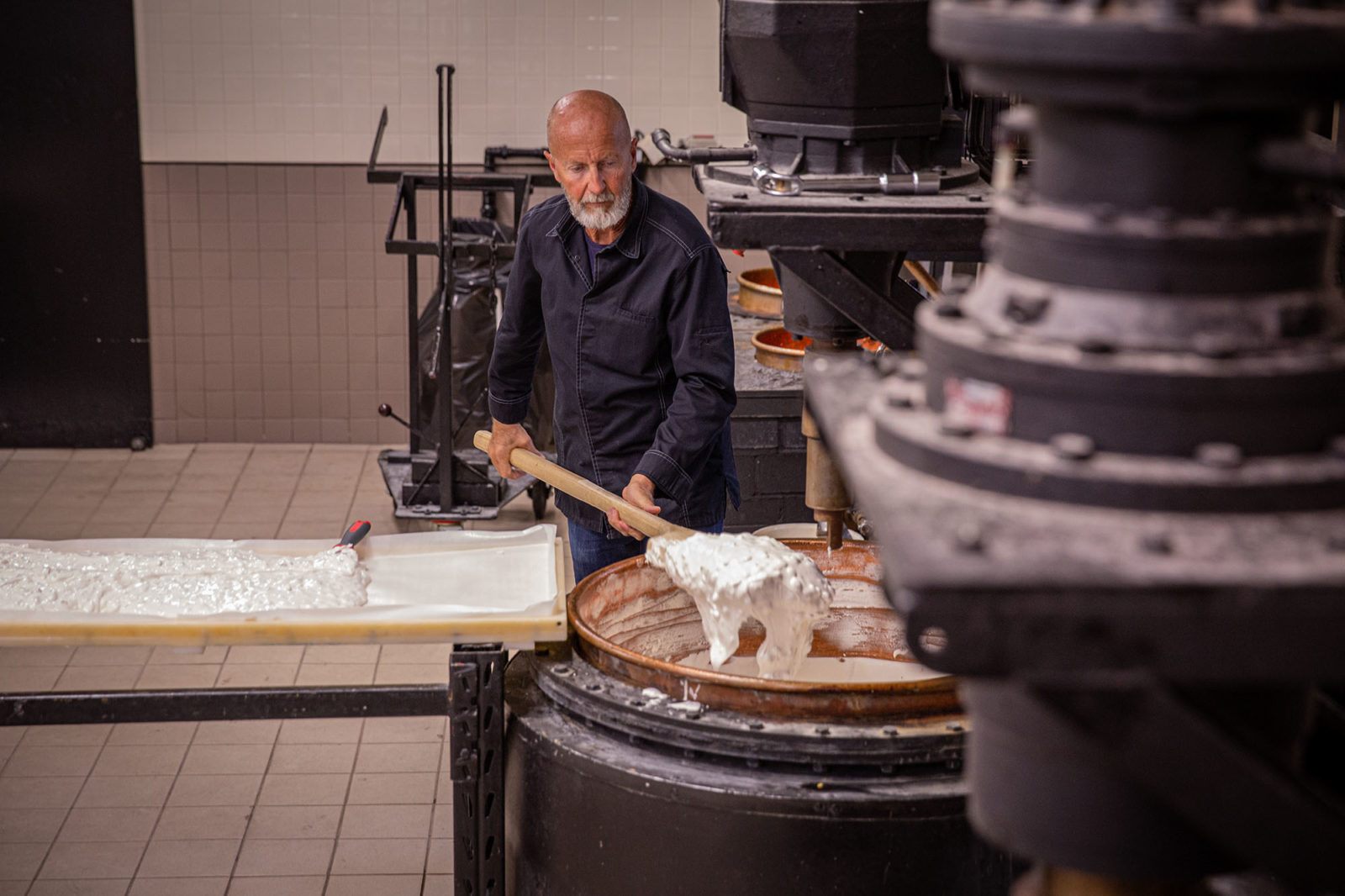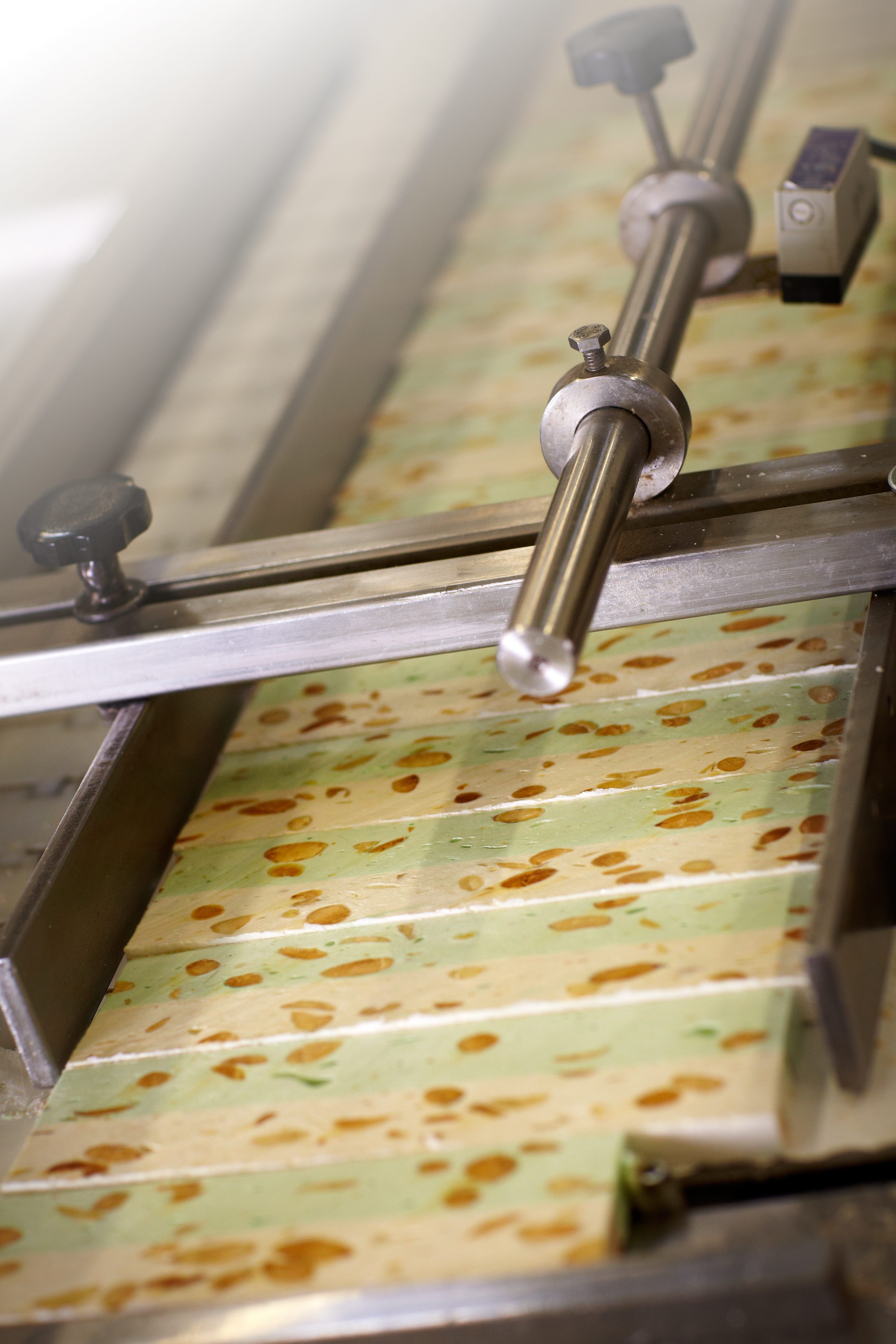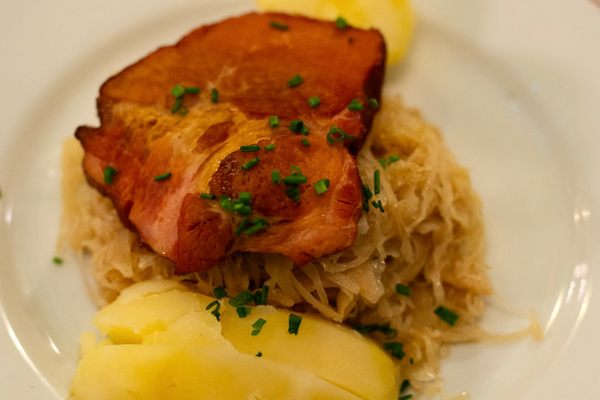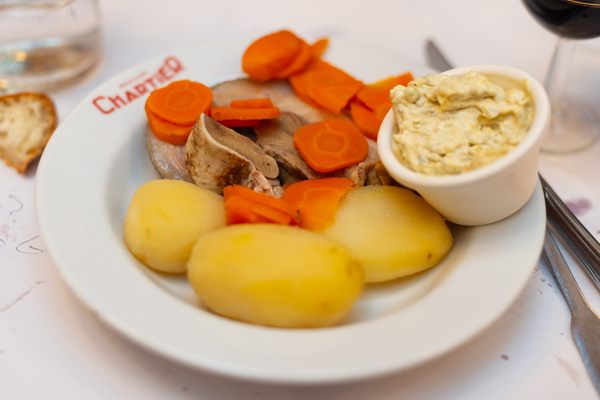How Summer Road-Trippers Put a Southern French Sweet on the Map
Montélimar nougat rose to fame thanks to vacationers’ traffic jams.
Many a French summer holidaymaker in the 1950s, stuck in an un-air-conditioned backseat on their way to the coast, would grow gleeful over an odd but charming sight: windows rolling down to welcome the wares of (car)door to (car)door nougat salesmen, peddling the confection along the infamous seven-hour traffic jams congesting the Nationale 7 trunk road—N7 for short.
This chewy, taffy-like treat is emblematic of the local terroir, featuring Provence’s lavender honey and sweet almonds. While nougat can be found anywhere from Marseille to Avignon, Montélimar, located about halfway between Lyon and the Mediterranean coast, has been a cradle for the confection for centuries—and the presence of nougatiers on the Nationale was a distinctly Montélimar phenomenon.
“The N7 made … I’m not sure if we can say the fortune of Montélimar,” says Didier Honnoré, co-president of Arnaud Soubeyran, one of the oldest nougatiers in the area. “But it definitely boosted the economy.”

During this time, local peddlers of nougat flourished, transforming what had been a pastry-chef side hustle of sorts into its own industry. But this heyday came to a swift end with the arrival of the freeway in the 1970s. The new road cut travel times to the coast but bypassed Montélimar, forcing the majority of its nougatiers to close their doors. If not for the ingenuity of local producers, Montélimar’s unique confection might have been lost forever.
The origin of nougat predates this tale of two highways by about three millennia, according to Marie-Claude Stoffel, the CEO of Chabert & Guillot, Montélimar’s largest nougat producer, and the co-president of the local nougat-makers’ guild. The confection that would inspire not just nougat but Italian torrone and Spanish turrón came to the Mediterranean in the Middle Ages by way of the Phoenicians.
“It looked like a meringue but with walnuts,” Stoffel says of the treat then-known as gâteau de noix, whose name, it stands to reason, evolved to give us the French word nougat.

While its first French port of call was likely Marseille, the relative paucity of nuts nearby meant that the recipe found a more permanent home elsewhere, notably in Montélimar and the surrounding regions of Drôme and Ardèche, where agronomist Olivier de Serres introduced almond trees in the 16th century. The local Mistral wind, known for its volatility and strength (and for being described by author Peter Mayle as being strong enough to blow the ears off a donkey), proved “magnificent” for nougat-making, according to Stoffel. Its drying effect on the soft confection renders a specific texture that makes it at once tough and tender—and less likely than other varieties to stick to the teeth. And while this led to nascent nougat industries in nearby towns such as Sault in the Vaucluse or Vallon-Pont d’Arc in the Ardèche, Montélimar’s nougat soon rose to fame thanks to a lucky location and advancements in transportation.
The Paris-Lyon-Marseille rail line (PLM for short) was built in 1849, passing through Montélimar on its way to larger cities farther south. At the time, Stoffel explains, the trains ran on steam and needed to stop to replenish their water and coal.
“And the obligatory stop before Marseille,” she says, “was Montélimar.”

Local nougat-makers would arrive at the station with baskets full of treats to sell to passengers through the train windows, and soon, Montélimar nougat was traveling across France, further boosted by Émile Loubet, president of the French Republic from 1899 to 1906 and the former mayor of Montélimar, who regularly offered it to visiting heads of state.
“It was so over the top that caricaturists always drew him with a bar of nougat on his back,” says Stoffel.
But with the arrival of modern, electric trains, Montélimar nougat’s first golden age would soon come to an end.
“Trains stopped less and less,” says Honnoré, “and people stopped off in Montélimar less and less.”

It took the advent of the now-infamous French paid holidays for the candy to get its second wind: The three weeks of leave granted in 1956 rose to four weeks in 1969. Northerners suddenly had enough time to holiday on the southern coast, and the Nationale 7 was the only way to get there.
“You could get up to seven or eight hours of traffic jams,” says Stoffel. “People would stop and picnic, and the hundreds of pastry chefs and nougatiers would come around and sell nougat.”
But modernization reared its ugly head once more in the late 1970s, when the autoroute arrived. “The day that the congestion on the Nationale 7 was relieved,” says Stoffel, “everyone started taking the freeway. No one came to Montélimar anymore.”
Local nougatiers refused to sit on their laurels. Led by Pierre Chabert, the fourth-generation head of Chabert & Guillot, they pushed for the right to sell their wares at the freeway’s new Montélimar rest stop. The government acquiesced, on two conditions: All producers must be represented, big or small, and they must band together to define a shared recipe. Ultimately penned by Chabert, the recipe called for a minimum of 30 percent nuts (either all almond or 28 percent almond and 2 percent pistachio) and 25 percent honey, as well as sugar and a binder like egg whites.

Producers could choose to stand out in small ways, adding vanilla, for instance, or choosing peeled or unpeeled almonds, but most variations preclude the product from using the name—and attract scorn from producers of the real thing. (Indeed, outdoor markets throughout France often welcome peddlers of massive blocks of nougat, sold by weight and garnished with all manner of fillings, from M&Ms to peanut butter swirls.)
Local producers like Chabert & Guillot keep their variations far lower-key—like their iteration featuring earthy, organic hemp seeds—or choose to evoke retro-infused nostalgia in their packaging, notably with a tin in the shape of the N7 road sign for Montélimar. Today, with 40,000 vehicles passing through and 300 tons of nougat sold every day, Montélimar boasts the largest—and most frequented—freeway rest stop in France.
Despite these developments, of the 22 nougat producers—and hundreds of sellers—who once worked in Montélimar, today, only 12 remain, of which Arnaud Soubeyran is the oldest and Chabert & Guillot the largest.

But the issues keeping this delicacy from the masses aren’t limited to access. Dry climes have become more of an impediment due to the effects of climate change. In 2022, the Drôme saw just 794 millimeters of rainfall, 20 percent less than the recent average, posing a problem for sourcing both honey and almonds.
This challenge is part of what drove Didier Honnoré’s son, Thomas, to leave his IT career in Paris to learn the art of almonds and honey in Châteauneuf-du-Rhône. After apprenticing with a beekeeper, he purchased local land to plant almond trees, which he now cultivates using organic methods. Today, 100 percent of his almond crop goes to Arnaud Soubeyran, used in a recipe he created with his brother Quentin. The nougat, made with Thomas’s lavender honey and skin-on organic almonds, is called the Nougat de Chez Nous, “The Nougat of Our Home.”

Thomas’s production represents a mere fraction of what Arnaud Soubeyran needs to respond to market demand. For their other nougat varieties, they still remain committed to sourcing locally: Honey comes exclusively from the Drôme and nearby Vaucluse and Ardèche. The eggs and sugar both come from France, and the almonds hail from France, Italy, or Spain.
“I’m going to hurt your feelings, but we don’t use Californian almonds,” says Didier Honnoré, alluding to the slight American accent I maintain despite living in France for 16 years. He cites intensive agriculture and “in our opinion, not enough taste” as deterrents to my native terroir. (I assure him I’m far from offended by his adherence to tradition.)
At the larger Chabert & Guillot, meanwhile, local sourcing can only go so far. Their sugar hails exclusively from France, as do 99.9 percent of their egg whites. Their nougat’s honey may hail from France or Spain. But almonds are another story.

Each year, as compared to the 20 tons of almonds used by Arnaud Soubeyran, Chabert & Guillot needs between 600 and 800 tons. France produces only 300 tons a year, and, Stoffel says, “it doesn’t want to sell them all to me.”
For now, the company relies on Spanish and Californian almonds, though Stoffel hopes that won’t continue for long. Five years ago, she signed a partnership with Compagnie des Amandes—a private investment fund with a goal of promoting and supporting almond producers in Provence, Occitanie, and Corsica. She hopes, in time, and with their help, to buy 150 tons of French almonds each year.

These moves toward an ever-more local product have spurred producers to protect the industry, especially against facsimiles made, according to Stoffel, “with gelatin and all sorts of things.” While the original charter allowed such additives, the nougatiers of Montélimar are currently petitioning for an IGP, a precursor to the AOC and AOP designations that define and protect such products of French terroir as Champagne. This IGP would notably narrow the production area to just 14 Rhone Valley towns and forbid the use of additives, including the gelatin that can hinder the development of that perfectly chewy, never-sticky texture in products worthy of the name nougat de Montélimar.
“Today, there are dishonest people taking advantage of artisan producers to do whatever they want,” says Honnoré, who remains committed to educating consumers about his product—especially now that an increasing interest in slow travel has led to an influx of local tourists intrigued by the area’s heritage.

Despite the presence of the faster freeway, more vacationers are opting to spend two or three more picturesque days driving along the Nationale 7 again. Along with the return of once-shuttered hotels and routier restaurants along the historic route, Montélimar’s nougatiers are experiencing a revival.
In 2000, Arnaud Soubeyran opened its first “museum”—a roped-off section of the factory where curious customers could watch nougatiers in action and learn the history of the local confection. After extensive renovations, the museum reopened as a more detailed, immersive experience with audio and video installations as well as games aimed at younger visitors. The updated museum opened just before the pandemic and was swiftly shuttered.
Upon its reopening in 2021, Honnoré recalls, the area was hit with an unusual and unexpected storm. Rain pelted the waiting guests, stretching out over “I don’t know how many hundred meters,” he says. He and his staff stepped out into the deluge, offering potential visitors a sweet treat while they waited, much as their ancestors had decades—and even centuries—before. And while, Honnoré recalls, he was “so embarrassed,” each of the waiting patrons welcomed him with a smile.
Gastro Obscura covers the world’s most wondrous food and drink.
Sign up for our regular newsletter.
























Follow us on Twitter to get the latest on the world's hidden wonders.
Like us on Facebook to get the latest on the world's hidden wonders.
Follow us on Twitter Like us on Facebook